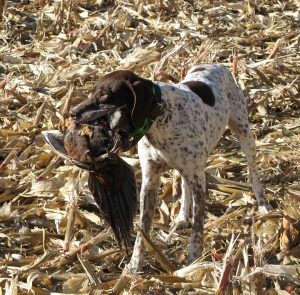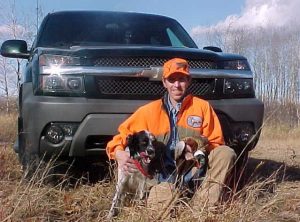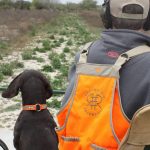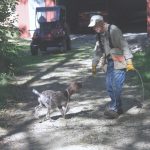First Season Series–Challenges: To Retrieve or Not to Retrieve?
POINTING DOG POINTERS February 2018
By Bob and Jody Iler
Last in our series of first season challenges is the issue of retrieving – one that often causes great concern in some of our dedicated hunter clients.
Last season, one of our customers with a young English setter called and asked, “Why won’t my dog retrieve yet?” Tom and his dog Jake had completed started dog classes at our kennel and been out in the field hunting several times that fall. We told him not to worry and that often, retrieving will begin as the young dog matures. We also reminded him about the role genetics always plays – if both parents are retrievers, it’s likely that pup will be. And the flip side is often true as well.
A week after his call, we went with Tom and Jake to a local game preserve. Jake pointed two chukars separately and handled well in the field. After each shot, Jake marked the bird’s fall and ran over and mouthed it. He picked up the last one briefly, dropped it, and continued hunting. Picking the bird up was a positive sign, but Tom wondered out loud whether he should “force break” Jake to retrieve.
At that stage of the young dog’s development, our advice was not to even think about it. Force breaking, or what we call the “trained retrieve,” can be always be done later, but we never recommend doing this advanced, intense training during a pup’s first season. Tom followed our advice for that season and let Jake have fun while gaining experience and developing his drive in the field. As Jake matured, with patience and lots of praise, his natural retrieve kicked in and he was delivering birds to hand like a pro.
It may take several seasons of hunting before that natural instinct to retrieve develops, but don’t give up and try to force it, especially with soft dogs. These types will react much better to lots of praise when they show interest in picking up the bird. Jake was a sensitive, soft dog and could have been ruined as a nice hunting dog if too much retrieving pressure had been put on him that first season.
To encourage pup to retrieve, it’s helpful to shoot smaller birds initially, such as quail or chukar, in the early stages of hunting, as they are easier to hold and carry. Doves, however, are smaller birds that may not be a good idea to shoot over young dogs. The pup can be discouraged from retrieving if he ends up with a mouthful of dove feathers, which come out easily. When you do plan to start shooting pheasants over your young dog, it’s often a good idea to have a trial run or two at a game preserve, where you can use hens to acquaint the pup with picking up a larger bird, and you won’t have to worry about pup getting spurred by a rooster.
If pup is a natural retriever, it may seem that the more retrieves he does, the better. Take care not to overdo this, especially in the first season. Some years back, we trained a young started German shorthair that was a natural retriever. The pup was later sold to a new owner down south who looked forward to having a dog that would retrieve, since his two pointers did not. The pup was run with the pointers on hunts, and sure enough, retrieved every bird that was shot over him. Soon though, it proved to be too much of a good thing. Too many birds were shot over this young dog – as he worked in the company of the other two that continued to hunt and not retrieve. He eventually lost his enthusiasm for retrieving and started to imitate his companions. In addition, it’s never a good idea to run a young dog with other dogs while they are still learning the ropes.
Extreme weather conditions can negatively affect a pup’s retrieve. Hot weather will overheat a young dog and often make him reluctant to pick up and hold a bird. It’s always a good idea not to hunt your pup when temperatures are too high. The same holds true for bitter cold or extremely rainy weather conditions. Common sense is in order when working the pup in his first season!
Although we don’t recommend using an e-collar on young dogs, and especially in a pup’s first season, you may have decided to use the e-collar in developing your pup – perhaps for extra emphasis in handling issues. Even if your dog is used to the e-collar, and particularly if he is not, never stimulate him with the collar while the pup is carrying a bird! Maybe he decided to run the other way with the bird, and you want him to come to you. Or he may be mouthing the bird and you want him to stop. Perhaps he’s not readily picking up the bird and you want him to do it faster, or maybe you want pup to drop the bird.
Remember that the e-collar is a tool to reinforce what has already been taught, and really has no place in the young started dog’s first season. You want your pup to make mistakes and have fun without putting the lid on his enthusiasm. We can just about guarantee that if you use the e-collar to stimulate your pup in any of the above scenarios involving a bird, he’s going to quickly drop the bird and may never want to pick it up again. You’ll dig a hole for yourself and your pup as far as his development goes. As an example, a friend of ours didn’t like the way his shorthair would take off with the bird and not come directly to him. He decided to bump her with the e-collar. Immediately, she dropped the bird and then came to him. After that, he couldn’t get her to pick up a bird.
For most dogs, there is a place for the e-collar in the trained retrieve program, should it become necessary as the pup matures. If you plan to campaign your dog in field events, often a retrieve to hand will be required. For this, it is important to teach the dog the trained retrieve first, to ensure a reliable retrieve at these events. Some soft dogs, however, just don’t take well to the pressure of a trained retrieve program. With these dogs, it’s usually better not to force the issue – or you many run the risk of turning a good dog off of birds.
In our experience, we’ve found that some of our own dogs that were a bit too soft for the trained retrieve later began to retrieve on their own. Because we valued their zest and drive and love for hunting more than a retrieve, we never put that pressure on them. When these sensitive types start retrieving on their own, it’s a special gift that reinforces our dedication to kind and gentle training that’s geared to our pup’s personality.
The pointing dog puppy already has her potential stored up inside when you pick her up at the breeder. If you’ve done your homework and chosen good bloodlines and parents with the traits you value in a hunting companion, your job is clear. Bring out the best in your pup using a fair, firm and gentle program that lets her set her own pace while you praise and encourage.
Pointing Dog Pointers features monthly training tips by Bob and Jody Iler, who own Green Valley Kennels in Dubuque, Iowa. Bob and Jody have trained pointing dogs for over 35 years and have written many articles for The Pointing Dog Journal.







